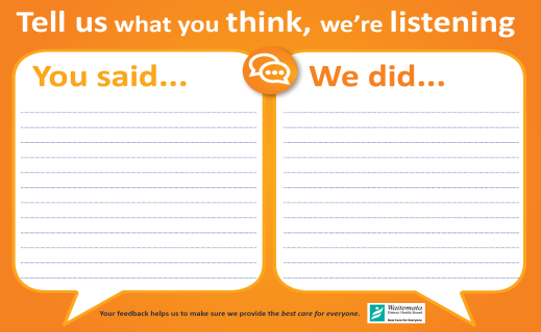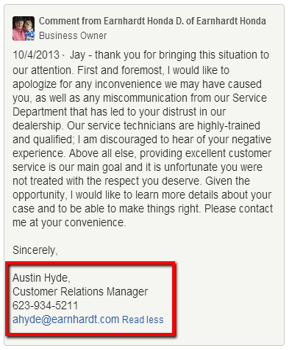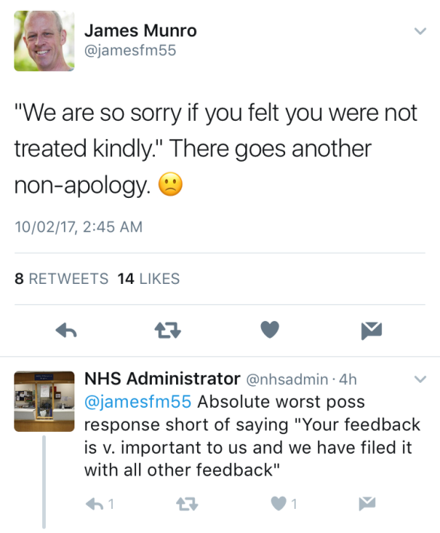How to respond to feedback
How to respond to Feedback
|
|
Online reviews are critical to the success of a local general practice. More and more consumers are making decisions about services from online reviews than ever before. Therefore, responding to online reviews is another critical piece in not only building a positive online presence, but also encouraging other patients to leave their feedback and engage with your practice.
|
Managing positive reviews
Responding to positive reviews is just as important as responding to negative reviews. Responding to a positive review is an easy way to engage with happy patients that benefits both your practice identity and your one-to-one relationship with that patient. Positive conversations online can enhance your practice’s reputation.
You should always respond to a positive review because:
- It is the polite thing to do – if a patient gave you a compliment directly, you would say thank you.
- Everyone is looking – 92% of consumers now read online reviews. Potential future patients of your practice may read this review – an opportunity for subtle marketing.
- It affects search rankings – by replying properly the review will show up in search results for practices.
|
| |
|
How to respond to a positive review
On each feedback item there is a flag that will enable any viewer to report if feedback is unsuitable. This feedback will be immediately removed from the site. Healthpoint does not moderate this process, although Healthpoint may reinstate feedback if it was maliciously removed.
- Thank them for taking the time to write the review or for visiting your practice and be specific.
- “Thanks for leaving a review and mentioning our receptionist Angela. You’re right - she is always smiling”
- Mention your practice name, so that review shows up within your search engine results
- “The team here at North Shore GPs is delighted to hear such great feedback about our staff and that we are the friendliest practice in Auckland”
- Highlight something that you are improving within your practice
- “We have recently conducted some patient experience training for our receptionists”
A great way to build trust and visibility with your practice online is to cultivate a strong, positive online presence.
|
Managing negative reviews
Negative reviews can be unpleasant for your practice to receive, however, if negative reviews are not responded to – this can lead escalate the situation. Don’t let online wounds fester - you can’t ignore a bad review by burying your head in the sand and hoping for the best. Dealing with negative reviews doesn’t have to be difficult, and it can even be leveraged as a positive opportunity. Remember the following:
- You are not just replying to one reviewer. You’re speaking to everyone who reads this review, including potential future patients of your practice.
- Replying is your opportunity to make things right. If a patient brings a complaint to you directly, you would make it right. Despite the impersonal nature of online reviews, it is not over. You can turn things around.
- Replying shows other readers you care and are not neglectful of feedback. You have taken steps to ensure the problem won’t happen to the next patient.
The best thing to do when responding to a negative review is to act quickly and make the most out of the less-than-pleasant experience.
|
How to respond to a negative review
- Apologise and sympathise in your response to the negative review. From the outset, acknowledge the patient’s concerns. Even if they are unfounded, show sympathy that they had a bad experience. “I’m sorry to hear about your experience.”
- Insert some positivity into the bad review – explain what the practice strives for. “We pride ourselves on providing positive patient experiences, and we regret that we missed the mark on this occasion”.
- Move the conversation offline. Provide contact info with someone at the practice so they can discuss the problem in person. “My name is…… and I am the Practice Manager. If you’d like to discuss this in further detail, please contact me on (provide number or email address).
- Keep your response simple, short and sweet. Don’t go into too much detail or ask any questions. This will prevent saying something that might cause upset and more negative feedback. Three sentences for the whole reply is a good rule of thumb.
The best thing you can hope for when responding to negative feedback is to have the unhappy patient revise or add another review because of how happy they are that their feedback was dealt with.
Embrace all ratings and reviews and use the feedback you receive as tools to identify areas of improvement within your practice.
- Demonstrate how you have used feedback

- Sincere and personal - promoting trust and tranparency with full contact details

- Ensure your apology is sincere

- A timely response, taking conversation immediately offline, however less personal. Avoid use of abbreviations

|




